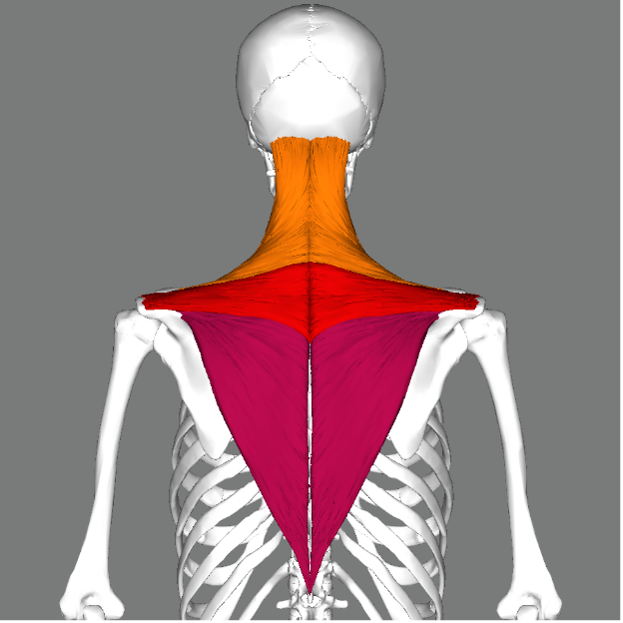How to reduce neck pain from screen time part 2: Muscle strengthening exercises
Learn a set of simple muscle strengthening exercises to reduce your neck pain.

Part 1 of this article described how screen time can contribute to neck pain due to overactive and weak muscles with examples of how to stretch those overactive muscles of the neck and back. This article describes how to strengthen particular muscles to help prevent and possibly reduce neck pain caused by slumping over while looking at a smartphone or a computer. These muscles include some of your deep neck muscles and your lower and middle trapezius. Regularly performing these exercises will also improve one’s posture. Below are some examples of exercises followed by additional tips.
Chin Tucks for Deep Neck Muscles

There are several deep muscles of the neck that are involved in flexing the chin to the neck. They can become weak over time and contribute to neck pain. One method to work these muscles is the chin tuck. To perform this exercise, lie on your back with the back of your head on the floor. Now, gently bring your chin down to your neck. You should feel a slight stretch in top of your neck near the base of your skull. Now bring your chin back to the starting position. If you feel like you are driving the back of your head into the floor, you are pressing too hard. This exercise can also be performed standing or sitting, with your back against a wall. Perform 2 to 3 sets of 20 or more reps most days of the week.
Y-Raises for Lower Trapezius Muscles
Anatomography, Trapezius muscle, commons.wikimedia.org
Part 1 of this article, explained how screen viewing habits can lead to tight upper trapezius muscles, and weak lower and middle trapezius. The lower trapezius, or lower trap, muscles are involved in several functions which include raising the arms overhead while pulling the shoulder blades down. Several exercises that strengthen the lower traps have been shown to reduce neck pain and improve neck function. The Y-raise is one of the best exercises to strengthen this muscle and it is performed by raising your arms back over your head in a Y-pattern.

To progress this exercise, perform it while standing in place and transition to performing it bent over at the waist. You can also lay down on your stomach on the ground to perform this exercise. Eventually, begin performing the exercise lying on your stomach on the edge of a bed or ideally on a gym bench. Once you can perform 15-20 repetitions, consider adding a light dumbbell in each hand while performing the exercise. Perform this exercise for 2 to 3 sets of up to 15-20 repetitions 2 to 4 days per week.
T-Raises for Middle Trapezius Muscles
The middle traps are muscles located on top of the lower traps and below the upper traps. This part of the trapezius muscles has several functions, most notably bringing your shoulder blades together. One of the easiest ways to strengthen this muscle is to perform a T-raise.

Photo: wikimedia.org
This is somewhat similar to the Y-raise, except you cannot perform a T-raise standing up straight. To perform, bend over at your hips while bringing your arms up so that they are in line with your shoulders and elbows. Now, simply raise your arms up. To increase the difficulty of this exercise, you can rotate your thumbs so they are pointing up. Once you can perform 15-20 repetitions, consider adding a light dumbbell in each hand. Like the Y-raise, the T-raise can be performed on a weight bench or on the ground as well. Perform this exercise for 2 to 3 sets of up to 15-20 repetitions 2 to 4 days per week.
Bonus Activity: Push-Up Plus
Strengthening other muscles that help stabilize the shoulder joint and assist with moving the shoulder blades down and forward can help reduce neck pain. Another good muscle strengthening exercise for this purpose is the push-up plus.

To perform this exercise, start in the push up position, or on your knees and hands as if performing a modified push-up. Your shoulder blades should be held back and down, and your torso should be parallel or nearly parallel to the floor with a flat back. Slowly lower your torso down to the floor. From the bottom position, press up through your hands. As you get to the top position, slowly extend your shoulder blades toward to the ground, while arching your back; this is the “plus” part of the movement. If you find this movement difficult, you can simply perform the top part of the movement and not the actual lowering part of the push-up. Perform this exercise for 2 to 3 sets of 10 to 15 repetitions a couple of days per week.
Additional Tips
There are several other exercises and tips that one can implement to reduce neck pain that also help with posture. For example, while driving a car, you can focus on keeping your shoulder blades back and down by feeling them compressed into the back of your seat. This will help you build up your endurance to maintain good posture the next time you are working on your computer or texting on your phone. Another huge tip is to modify your current work station and make it more conducive as a less painful work environment.
Regularly performing both these stretching and muscle strengthening exercises can help reduce neck pain that we all may experience from the time we spend on screens. For further resources on how to perform other muscle strengthening exercises and other posture exercises, please visit the MSU Extension’s Physical Activity website.



 Print
Print Email
Email

